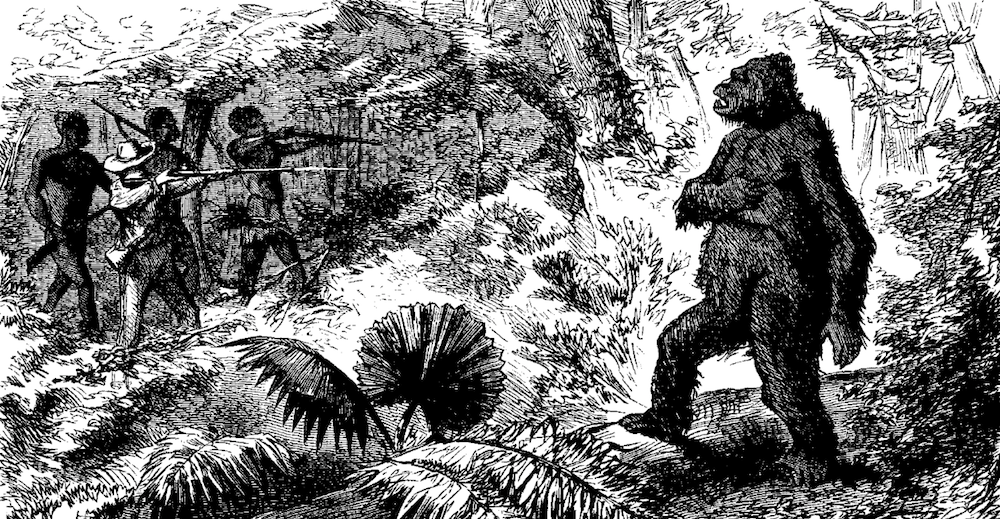Footnotes:
Animal extinction is a frequent topic of this podcast. Frankly, it’s becoming an alarmingly frequent topic in our daily lives. When we hear that, for example, we’ve lost a subspecies of Black Rhino, we think “there goes another one.” We’re so used to species disappearing that when a new species appears, well, that catches us off-guard.


We tend to think about some animals as permanent elements of the world, but you’d be surprised at how recently they were discovered. The gorilla, for example, has only been known to us for about 160 years. The Western Lowland Gorilla made its debut to Western science in the 1860s, and the larger Mountain Gorilla was thought to be a myth for another 50 years.

Rumors of an enormous, hairy creature lurking in unexplored Africa had been circulating since at least the time of the ancient Greeks, and as Europeans began their attempts to penetrate the African interior, tales of these horrid man-beasts became unavoidable. In 1847, the anatomist Reverend Thomas Savage obtained skeletal remains of a large, then-unknown primate from natives in the Gabon region of West Africa, confirming that there was indeed something out there. However, he himself never sighted the animal, so scientists had to piece together what they could from the bones and descriptions from the indigenous people.

The bizarre combination of leaps in logic and fragmented information lost in translation resulted in a portrayal of the gorilla as an almost supernatural behemoth. The gorilla was said to be driven by rage, and powerful enough to kill an elephant in single combat. At the sight of a woman, the gorilla would become so overcome by amorous excitement that it would be compelled to grab at her, likely crushing her to death in the process.

Here’s an attempt to describe the gorilla from famed naturalist Richard Owen after he’d conferred with Thomas Savage about the bones collected in Gabon:
“They are extremely ferocious, and always offensive in their habits, never running away from man as does the Chimpanzee…The hunter awaits his approach with gun extended; if his aim is not sure he permits the animal to grasp the barrel, and as he carries it to his mouth he fires; should the gun fail to go off, the barrel is crushed between his teeth, and the encounter soon proves fatal to the hunter…
Negroes when stealing through shades of the tropical forest become sometimes aware of the proximity of one of these frightful formidable apes by the sudden disappearance of one of their companions, who is hoisted up in the tree, uttering, perhaps, a short choking cry. In a few minutes, he falls to the ground a strangled corpse.”

It wasn’t until a young explorer named Paul Du Chaillu returned from an expedition to Gabon with the first specimens and firsthand reports of the gorilla that a more accurate picture began to form. Du Chaillu wrote in his published account of his journey Explorations and Adventures in Equatorial Africa that the gorilla was in reality a shy vegetarian that preferred solitude when possible, and had absolutely no inclination of kidnapping village maidens. However, Paul was a born storyteller prone to boastful claims and embellishments for dramatic effect. Packing his tale with action and heroism was in his best interest, and his descriptions of the gorilla proved to be a double-edged sword.

He included in his book that while gorillas were known to stay away from human populations, humans should hope they never crossed paths with the beast. At the slightest provocation, a gorilla could become a hellish embodiment of wrath, a fierce monster that could tear through men like paper. His misrepresentations of the relatively peaceful animals would inspire such films as King Kong and Tarzan, and characters like The Lost World’s Professor Challenger were based in part on Du Chaillu’s storytelling style. His book would also inspire decades of gorilla hunting, both in the name of science as museums trying to procure their own specimens and by hunters trying to fell the legendary beasts as trophies, which dropped gorilla populations to dangerous lows.

Paul Du Chaillu was the first man to return from Africa with tangible evidence of the gorilla’s existence: taxidermied specimens that the scientific community and the public could see with their own eyes. Never before had the people seen a creature that looked at once so human and yet so alien. Paul Du Chaillu became an instant celebrity in Britain, where he toured the country giving lectures on his findings and recounting his adventures in grandiose fashion.

He found himself suddenly welcome in Britain’s elite class, afforded a level of celebration and recognition that other scientists had spent whole careers trying to reach. However, in an age where breakthrough discoveries were a dime a dozen, many of his peers scoffed that Du Chaillu was no real scientist. His gorilla was just the “lion of the season,” a passing fad that would be forgotten before the year’s end.

Indeed, the spotlight wouldn’t last long. Beneath the surface-level envy of Paul Du Chaillu’s naturalist colleagues, two powerful forces were aligning against him: Evolution Theory and “scientific” racism. Darwinian Evolution had hit London like a freight train just as Du Chaillu was returning from his expedition. The world wasn’t fully grasping the slow change required for evolution to work, so the idea of man somehow transmuting from apes seemed preposterous even to supporters of the theory. That is, until Paul showed up with an ape that was alarmingly human.


Opponents and supporters alike seized on the gorilla. Some saw its similarities as undeniable evidence that man had evolved from primates. Others pointed to its differences as proof of the opposite. After all, they argued, it’s not as if men had hands for feet. And then there were those with more malicious intent. This was the era of craniology, the study of human skull sizes and measurements to establish a hierarchy or superiority among different races. The discovery of the gorilla and it’s “primitive” skull provided an insidious opportunity to compare and prove once and for all that non-white races were degenerate. It was an especially common belief among scientists of the day that black people were the lowliest humans because they were closest to apes.


Du Chaillu was battered by arguments from every corner of the fight. Did he believe in evolution or did he not? Was he a heretic? What was his stance on race? Did he harbor sympathies for non-white races? The animosity hit a fever pitch when Du Chaillu’s peers learned that his mother was black. Suddenly his spectacular stories were fantastic exaggerations brought on by his “negro blood.” His critics called into question whether he had actually undertaken the expedition he’d written so extensively about, an accusation that was further exacerbated when some of his companions from that journey claimed that parts of his story were false or that they had not received due credit for their role in the experience. Many wondered whether or not Paul Du Chaillu could really be considered a naturalist at all.

Du Chaillu’s career might have collapsed under the weight of such vindictive scrutiny, if not for his incredible resilience. Men of science were calling him a phony, so he countered them with factual evidence to the contrary. Du Chaillu returned to Africa on a second expedition and the following year, he returned with several undeniably new species of birds and mammals. After the undignified treatment he’d received from London’s top scientific minds, however, he chose to end his career on his own terms. He retired from the pursuit of Natural History and spent his later years living in Scandinavia where he authored several books for children and adults.

If you missed the previous episode about the Mary and Louis Leakey, I recommend listening to it now. Consider what a difference race played in the lives of Paul Du Chaillu and Louis Leakey. Both men were raised in Africa, both found missing-link type primates in their respective eras, and both were charming “ladies-man” adventurers. Yet while one endured a sort of scholastic persecution at the hands of his colleagues, the other went on to define Africa as the home of human ancestry. Granted, they lived about 4 decades apart and a lot can change in that amount of time, but how differently would things have gone for Louis Leakey if he’d been black?

Sources:
The Species Seekers: Heroes, Fools, and the Mad Pursuit of Life on Earth by Richard Conniff
Explorations and Adventures in Equatorial Africa by Paul Du Chaillu
Race, Sex, and the Trials of a Young Explorer by Richard Conniff
The Myth of the Ferocious Gorilla by Boyce Rensberger
Mountain Gorillas and King Kong by The Gorilla Highlands Blog
Museum Management:
Museum theme by Michael Guy Bowman
Listen to more at: bowman.bandcamp.com
Rachel: Designer #UkuleleWitch @rachelvice
Tour Guide: Emery Coolcats
Twitter: @natmysterycast | Email: natmysterypodcast@gmail.com | Home: pome-mag.com/category/pomecast
Follow the show on iTunes or Soundcloud!
Museum of Natural Mystery is part of the POMEcast network, and thanks a million to the ladies of POME for helping this show get up and running! But above all, thank you for listening! We’ll see you next time!




